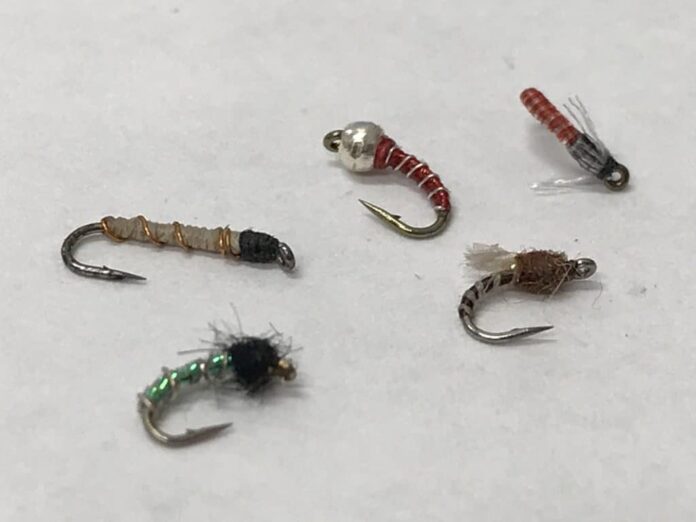Michael Salomone/Courtesy photo
Midges rule the local water for the next few months. Sporadic hatches of Blue-Winged Olives (BWOs) may appear, but the mainstay for repeatable success rides on the smallest nymphs in your fly box. If these five must-have midge nymphs are not in your box already, it’s time to get to the fly shop.
When we target winter nymphing, the earliest stages in the midge life cycle are the focus — the larva and pupa stages. The cold water holds insects in these two stages for an extended period as they waiting for conditions to be ideal enough to emerge. The high number of midge nymphs in the river create a reliable food source throughout the winter months.
The hatches are sparse, at times, in the winter months. Some type of warmth is needed to spur the activity. Whether it is the radiant rays of the sun or a warm-water seep in the riverbed, warmth is needed in the winter for a midge hatch. The development from larva into pupa can take time. Therefore, fishing midge nymphs is the key to repeatable success in the cold.
Larva stage is the first stage in insect development. Midge larva have a thin, segmented body and small head. When it comes to midge larva, red is the No. 1 color to use. We can have a long discussion about why they are red, but that could take more room than I have available. Let’s just say, go with red first; olive is a good second color choice for midge larva flies.

Michael Salomone/Courtesy photo
Deep, bright red and fished deep where the insects thrive in the detritus all winter long, is the key to nymph fishing with midge larva imitations. A quick sampling of the decaying leaves on the bottom of the river yields high numbers of the bright red, worm-like midge larva. A winter insect sampling isn’t something most anglers want to do to their hands, but it can yield a tremendous amount of information to steer your angling — such as size of the larva and exact color. Anglers can gain a sense of the amount of insects in a specific area.

Support Local Journalism
The pupa stage is next in development. The thin, uniform body of the midge larva stage has progressed into a distended head or thorax. The body is still visibly segmented but the distended section holds the developing wings. Dark colors — black or brown-tied with a thread or dubbing head — fish more effectively. The unweighted nymph rides in the middle of the water column where midge pupa are staging for an emergence.

Roaring Fork rainbow release.
The little flies are actively rising, but at a slow winter’s pace. This stage requires more attention to weights for keyed presentations whereas the larva stage can be banged along the bottom for the best success. When it comes to my personal angling, I use micro-shot to dial in my presentation. The use of small weights can be taxing when applying, but the benefits enhance my personal angling. Can I say my clients would notice? No. But, a knowledgeable angler who feels the connection through their rigging will notice the results.
The five mightiest of the itty bitties for winter angling on the Eagle River are the Beadhead Zebra midge, Disco midge, Top Secret midge, Miracle midge and the Jujubee midge. Are there others? Yes, but with these five patterns, any angler will encounter successful winter fly fishing.
Beadhead Zebra midge (red): to the best of my knowledge the fly originated in Arizona by a Lees Ferry guide during the 90s.
Disco midge: tied thin with a dark head and nothing but flash for the body.
Top Secret midge (brown): this fly was created by a Colorado midge guru, Pat Dorsey.
Miracle midge (white): it is such a nondescript fly, but the body segmentation can be easily created with thread or wire for a different presentation.
Jujubee midge (red): a local favorite. The white emerging wings attract attention and indicate vulnerability but stay small.

Michael Salomone/Courtesy photo
Winter fly fishing on the Eagle River gives anglers a silent retreat from the busy ski season. The slow, deliberate pace requires focus, diligence and a certain degree of toughness not usually associated with fly fishing. Go ahead and tell your buddies you went fly fishing on your ski trip. Tell them you stood in the middle of a freezing river with slush ice rolling past you while you caught trout on the mightiest of the itty bitty flies in your box.

Michael Salomone/Courtesy photo





























